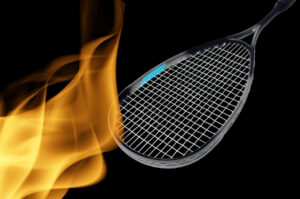When you are looking for a new tennis racket, there are many factors that you will need to consider – like a flexible tennis racket frame for example.
One of the most important decisions you will make is whether to choose a stiff or flexible frame.
In this blog post, we will discuss the advantages of flexible tennis racket frames.
If you are unsure which type of racket is right for you, keep reading! We will help you make the best decision for your game.
What is a flexible tennis racket frame?
A flexible tennis racket frame is a type of racket that is designed to be more flexible than a stiffer frame.
A frame that is more flexible will absorb more energy, which leads to a loss of power when hitting the ball.
When you use a flexible frame on touch shots like volleys or drop shots, you’ll notice an increased connection with the ball. This results in a more plush feel overall.
What are the advantages of a flexible tennis racket frame?
The main advantage of having a flexible tennis racket frame is that it provides a soft feel as it becomes more bonded with the ball.
The more flexible a racquet is, the greater its ability to bend and absorb energy.
This means that it is less likely to cause injuries and is also more comfortable for beginners who are still learning the proper technique for their swings.
In addition, a flexible racket frame can help you control your shots better.

What are the disadvantages of a flexible tennis racket?
Although a flexible racket has many advantages, there are also some disadvantages that you should be aware of.
One disadvantage is that a flexible racket absorbs more of the energy from impact, and less energy can be returned to the ball.
One of the most common reasons for a racquet’s failure to provide consistent power and accuracy is due to its flexibility.
A tennis racquet, for example, might be too flexible or absorb too much ball energy, resulting in no power.
So, what is the best type of racket for you, a flexible or stiffer frame?
The answer to this question depends on your individual playing style.
If you are a beginner, you may want to start with a flexible frame to help you learn the proper technique, and can help you control your shots better.
If you are an aggressive player, you may want to consider a stiffer frame because, If a frame is more rigid, it will absorb less shock upon impact, meaning that more energy stays in the ball instead of being absorbed by the frame.
This results in greater power behind your shots.
Now that you know the advantages and disadvantages of flexible tennis rackets, you can make an informed decision about which type of racket is right for you.
What is considered a flexible racquet frame?
The stiffness scale of racquets typically ranges from 50 to 85, with the lower number representing a more flexible racquet and the higher number signifying a stiffer one.
In reality, most contemporary racquets fall between 60 to 75.
What is the most flexible tennis racket?
The most flexible tennis racket on the market is:
The Wilson Triad XP5 Racquet with a Stiffness Rating of 46.
The Prince Phantom Pro 100 with a Stiffness Rating of 54.
The Wilson Clash 100L with a Stiffness Rating of 54.
The Head MicroGEL Radical OS with a Stiffness Rating of 56.
To purchase the rackets above please click here.
In conclusion:
A flexible tennis racket frame has many advantages, including a soft feel and increased control. However, there are also some disadvantages to consider, such as the loss of power.
The best type of racket for you depends on your individual playing style.
If you are a beginner, you may want to start with a flexible frame. A flexible frame is more comfortable for beginners who are still learning the proper technique for their swings.
In addition, a flexible racket frame can help you control your shots better.
If you are an aggressive player, you may want to consider a stiffer frame, because, If a frame is more rigid, it will absorb less shock upon impact, meaning that more energy stays in the ball instead of being absorbed by the frame.
This results in greater power behind your shots.
The stiffness scale of racquets typically ranges from 50 to 85, with the lower number representing a more flexible racquet and the higher number signifying a stiffer one.
I hope you enjoyed learning about the advantage of a flexible tennis racket frame.
Stay tuned for more posts about interesting topics in the world of tennis!
If you have any questions or comments about What is the advantage of a flexible tennis racket frame? Let me know in the comments below, and I will be happy to answer you!
And make sure to check out my other blog posts for more informative guides.
Thanks for reading, and happy playing! 🙂








